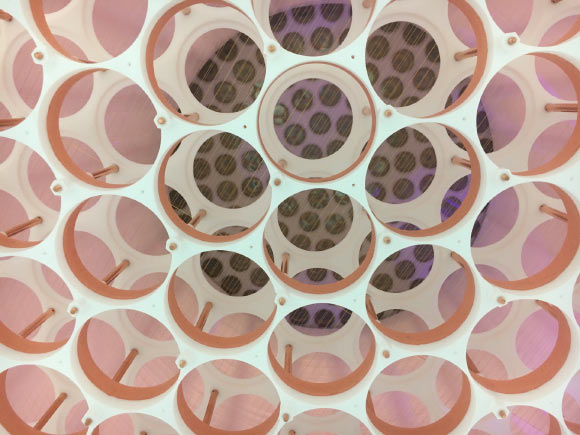
Some unexplained results from the XENON1T dark-matter detector — a 1,300-kg vat of super-pure liquid xenon shielded from cosmic rays in a cryostat submerged in water deep 1.5 km beneath the Gran Sasso mountains of Italy — may have been caused by dark energy particles produced in a region of the Sun with strong magnetic fields, and not the dark matter the experiment was designed to detect, according to physicists from the XENON Collaboration.
One photodetector array of the XENON1T detector seen through the other. Image credit: XENON Collaboration.
“Despite both components being invisible, we know a lot more about dark matter, since its existence was suggested as early as the 1920s, while dark energy wasn’t discovered until 1998,” said Dr. Sunny Vagnozzi, a physicist in the Kavli Institute for Cosmology at the University of Cambridge.
“Large-scale experiments like XENON1T have been designed to directly detect dark matter, by searching for signs of dark matter ‘hitting’ ordinary matter, but dark energy is even more elusive.”
To detect dark energy, scientists generally look for gravitational interactions: the way gravity pulls objects around.
And on the largest scales, the gravitational effect of dark energy is repulsive, pulling things away from each other and making the Universe’s expansion accelerate.
About a year ago, the XENON Collaboration reported an unexpected signal, or excess, over the expected background.
“These sorts of excesses are often flukes, but once in a while they can also lead to fundamental discoveries,” said Dr. Luca Visinelli, a researcher at Frascati National Laboratories.
“We explored a model in which this signal could be attributable to dark energy, rather than the dark matter the experiment was originally devised to detect.”
At the time, the most popular explanation for the excess were axions — hypothetical, extremely light particles — produced in the Sun.
However, this explanation does not stand up to observations, since the amount of axions that would be required to explain the XENON1T signal would drastically alter the evolution of stars much heavier than the Sun, in conflict with what the researchers observe.
They then constructed a new physical model, which used a type of screening mechanism known as chameleon screening, to show that dark energy particles produced in the Sun’s strong magnetic fields could explain the XENON1T excess.
“Our chameleon screening shuts down the production of dark energy particles in very dense objects, avoiding the problems faced by solar axions,” Dr. Vagnozzi said.
“It also allows us to decouple what happens in the local very dense Universe from what happens on the largest scales, where the density is extremely low.”
The researchers used their model to show what would happen in the XENON1T detector if the dark energy was produced in a particular region of the Sun, called the tachocline, where the magnetic fields are particularly strong.
“It was really surprising that this excess could in principle have been caused by dark energy rather than dark matter. When things click together like that, it’s really special,” Dr. Vagnozzi said.
Their calculations suggest that experiments like XENON1T could be used to detect dark energy. However, the original excess still needs to be convincingly confirmed.
“We first need to know that this wasn’t simply a fluke,” Dr. Visinelli said.
“If XENON1T actually saw something, you’d expect to see a similar excess again in future experiments (such as XENONnT, PandaX-4T, and LUX-ZEPLIN), but this time with a much stronger signal.”
The team’s paper was published in the journal Physical Review D.
_____
Sunny Vagnozzi et al. 2021. Direct detection of dark energy: The XENON1T excess and future prospects. Phys. Rev. D 104, 063023; doi: 10.1103/PhysRevD.104.063023
 #Bizwhiznetwork.com Innovation ΛI |Technology News
#Bizwhiznetwork.com Innovation ΛI |Technology News



